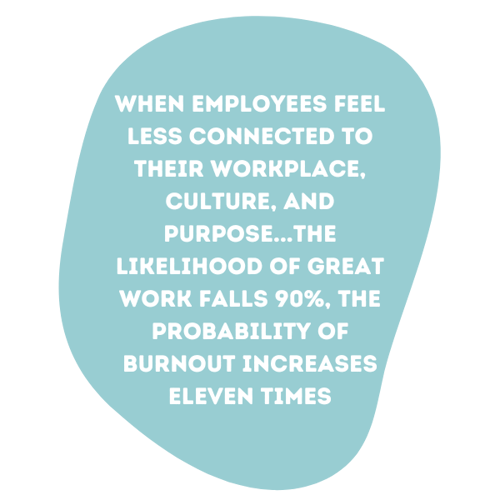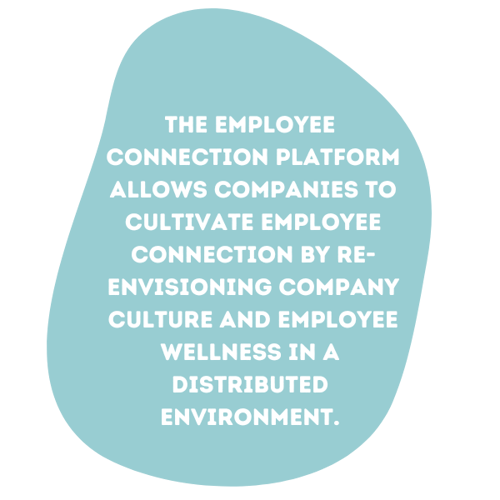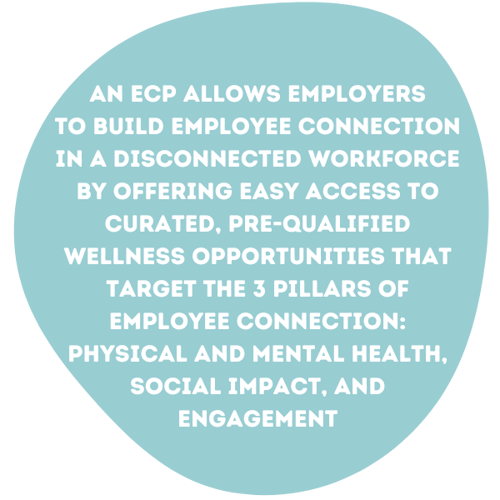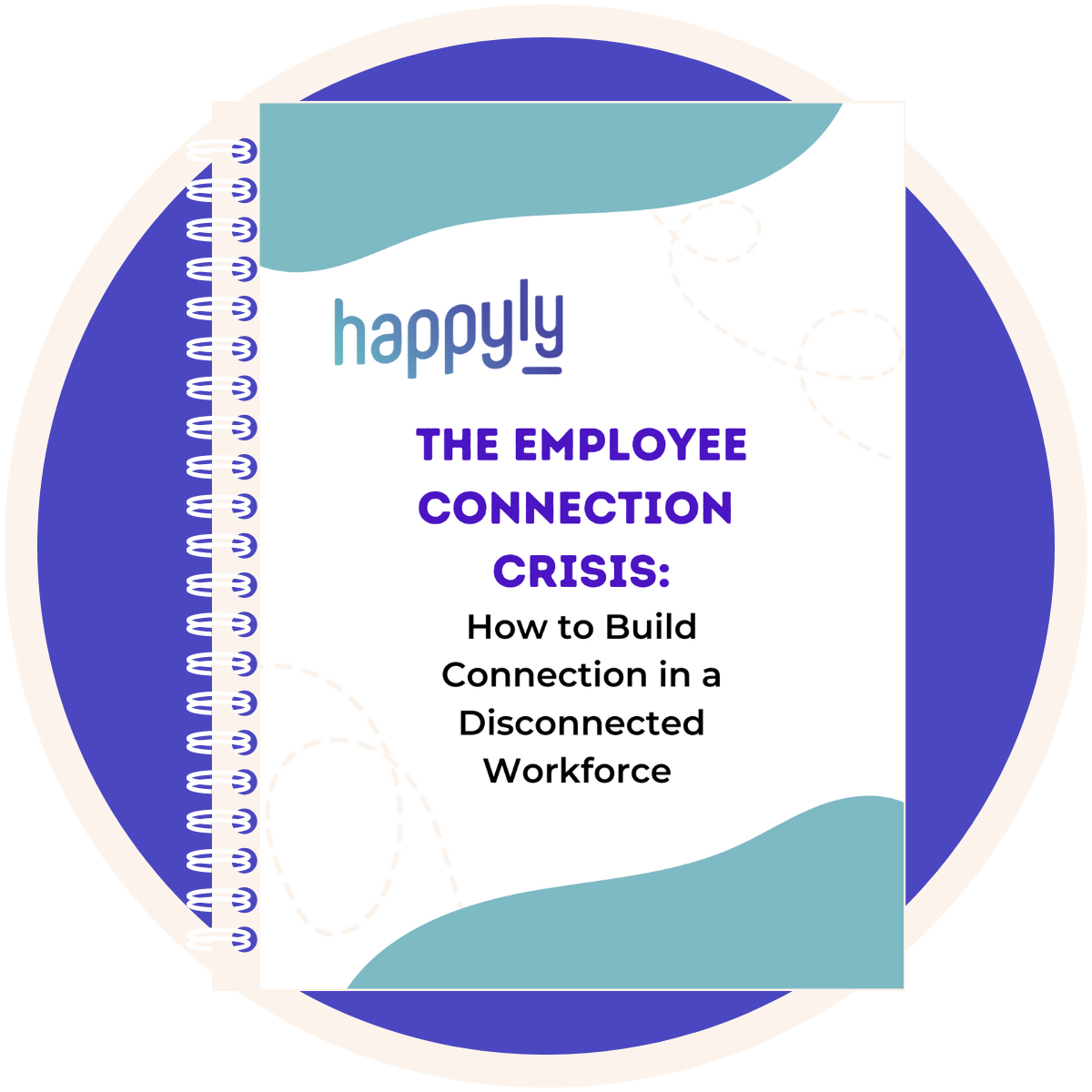The Employee Connection Crisis
How to Build Connection in a Disconnected Workforce
Executive Summary
An Employee Connection Crisis
Today’s employers are facing a crisis. Only one in four employees currently feel connected to their organization. This has critical implications. “When employees feel less connected to their workplace, culture, and purpose...the likelihood of great work falls 90%, the probability of burnout increases eleven times, and the odds that employees will leave within three years surges six times,” reports O.C. Tanner in their 2022 Culture Report.
The resulting attrition is costly. Losing an individual employee costs anywhere from one-half to two times the employee’s annual salary—plus the immeasurable cost of losing a seasoned employee. This means that a 100-person organization with an average salary of $50,000 could have turnover and replacement costs of approximately $660,000 to $2.6 million per year.
An increase in remote work is a driving factor in this crisis. Employees feel connected to their company when they identify with, care about and feel like they belong in the company culture. Prior to 2020, this was often accomplished with in-person perks, bonding opportunities and events. But a hybrid work environment has become the new norm. 92% of companies now expect at least some of their employees to work remotely. This leaves many employers at a crossroads: they recognize the urgent need to recultivate connection, yet they’re saddled with pre-pandemic tools that are no longer relevant.
What’s the solution?
Companies are turning to innovative, hybrid-friendly benefits that re-envision company culture and employee wellness in a distributed environment. This has led to the rise of a new category of benefits: the Employee Connection Platform (ECP). An ECP provides employees with easy access to curated, pre-qualified wellness opportunities local to them. Employees can use an ECP to achieve personal goals or to participate in company-wide opportunities that help bring teams together, even when they’re physically apart.
An ECP targets the 3 Pillars of Employee Connection: physical and mental health, social impact, and engagement. On their own, each of these pillars of connection is valuable. But their convergence in the same platform maximizes their impact, fostering 360-degree wellness while connecting employees to company culture. The result is happier, more deeply connected employees. This in turn drives productivity and retention—for a powerful return on investment.
The Employee Connection Crisis
Today’s employers are facing a crisis. Only one in four employees currently feel connected to their organization. This lack of connectedness is felt across the board: in small companies and large companies, with new hires and tenured employees, and in every age group and gender.1
Employees feel connected to their company when they identify with, care about, and feel like they belong in the company culture.2 Prior to 2020, this was often accomplished with in-person perks, bonding opportunities and events. But today’s workplace looks different. In the wake of the pandemic, the majority of companies have rethought their in-person requirements—with lasting impact. 92% of companies now expect at least some of their employees to work remotely.3 That results in nearly half of the American workforce working remotely at least part of the time.4 A hybrid work environment has become the new norm.
“How are we living culture today in this more hybrid work environment?” asks Alexia Cambon, Research Director of Gartner HR. “We’re not living it primarily in the office anymore. We’re living it in all sorts of different places.”5 This dispersed culture creates new barriers and challenges for companies trying to foster employee connection, with the tools and methods used in the past no longer sufficient.
The Deep Impact of Employee Connection
When employees don’t feel connected to their company, it sets off a chain reaction that is felt at every level of the business. A lack of connection leads to plummeting engagement and satisfaction levels, resulting in a drop in productivity and retention—and ultimately profits.“ When employees feel less connected to their workplace, culture, and purpose...the likelihood of great work falls 90%, the probability of burnout increases eleven times, and the odds that employees will leave within three years surges six times,” reports O.C. Tanner in their 2022 Culture Report.6
This chain reaction is sending shockwaves through the modern business landscape. More than 40 million people left their jobs in “The Great Resignation” of 2021.7 This pandemic-driven attrition is a pervasive problem. 91% of HR leaders are increasingly concerned about employee turnover.8 And rightfully so: low retention is expensive.
To replace an individual employee costs anywhere from one-half to two times the employee’s annual salary.9 If the average engineer at a tech company makes $133,205,10 then replacing that employee would cost between $66,602 to $266,410. When viewed from an overall company perspective, a 100-person organization with an average salary of $50,000 could have turnover and replacement costs of approximately $660,000 to $2.6 million per year.11 That expense is just the beginning. “Losing your best people means losing your reliable winners, your constant innovators and your most effective problem solvers,” Gallup explains.12
So, how can companies stem this expensive loss of employees? “The global pandemic has made workers reevaluate what they are actually getting out of their jobs—or more pointedly—what they aren’t,” explains a Forecast Report by Inspirus. “Most are not feeling valued...or aren’t sharing a sense of purpose or community with their peers or their employer.”13
Cultivating Connection in a Disconnected Environment
The “Great Resignation” has shone a spotlight on the pressing need for companies to strengthen employee connectedness. O.C. Tanner proclaims there’s “a new opportunity for HR leaders: reconnecting their people...Employers have an urgent need to reestablish and strengthen the bonds employees feel between each other and the organization.”14

This leaves many employers at a crossroads: they recognize the critical need to recultivate connection, yet they’re saddled with pre-pandemic tools that are no longer relevant. To solve this challenge, companies are turning to innovative, hybrid-friendly benefits that meet their employees wherever there are. This has led to the rise of a new category of benefits: the Employee Connection Platform (ECP). The Employee Connection Platform allows companies to cultivate employee connection by re-envisioning company culture and employee wellness in a distributed environment.
“Employees are looking to their employer to provide support on all areas of well-being,” said NBGH President and CEO, Brian Marcotte, in an article for the Society of Human Resource Management. “Not just physical health programs...but those designed to help employees meet their...mental, community and social health goals.”15 This means looking at 360-degree wellness.16 Companies can use an Employee Connection Platform to meet the needs of the whole employee, during work hours and beyond.
The benefits are far-reaching. 70% of workers enrolled in a workplace wellness program have reported “higher job satisfaction” after enrollment.17 That satisfaction generates a huge return on investment. On average, for every dollar spent on employee wellness, medical costs fall $3.27 and absenteeism drops $2.73—resulting in a 6-to-1 return on investment.18
The Employee Connection Platform (ECP)
The Constitution of the World Health Organization (WHO) defines health as a state of complete physical, mental and social wellbeing.19 This definition is at the heart of the Employee Connection Platform. By empowering employees to live healthy and connected lives, both at home and in the office, the ECP is redefining wellness.
An ECP offers access to local, curated wellness opportunities and activities, deepening employees’ connection to both their company and community. Employees can utilize individual activities to achieve personal goals or participate in company-wide opportunities that have the power to bring teams together—even when they’re physically apart.
An ECP targets the 3 Pillars of Employee Connection: Physical and Mental Health, Social Impact, and Engagement. Let’s take a closer look at how each pillar empowers healthy, connected lives.
Physical and Mental Health
Easy, local access to activities that foster a healthy lifestyle has immeasurable benefits. Experiencing nature is one such powerful activity. “Allowing workers more meaningful access to nature...facilitates higher well-being and performance,” reports the Wall Street Journal. It “improves people’s moods, sharpens people’s cognitive abilities, makes them more cooperative, reduces burnout, and enhances employees’ productivity.”20
Community involvement has similar benefits, which has been coined the Participation Phenomenon by Mark Pancer, Professor Emeritus of Psychology of Wilfrid Laurier University in Ontario. “Research has shown consistently that when individuals participate in the life of their community, they experience substantial benefits... not only do they live longer, but they feel healthier, both physically and emotionally,” Prancer explains.21
In spite of the many established benefits of a healthy, active, community-oriented lifestyle, the time required to source and plan activities often creates a barrier to entry for busy employees. The ECP breaks down that barrier by placing already-curated activities and opportunities at an employee’s fingertips.
Social Impact
The extensive health benefits of giving back have long been established. Of individuals who volunteer, “76% felt healthier and 94% were in a better mood” afterward.22 The Journal of Happiness Studies adds that volunteering makes “someone as happy as having an extra $1,100.”23
This impact resonates within a company as well. Of the 1,000 employees surveyed by Deloitte, 70% believed that volunteer opportunities boosted morale more than company mixers, 77% believed that volunteer activities are essential to employee well-being, and 78% thought companies who sponsored volunteer activities created a better working environment than those who did not. Yet in the same survey, 69% of employees said they do not volunteer as much as they would like.24
There’s a clear disconnect: the majority of employees value giving back, yet they don’t do it as often as they would like. An ECP resolves this by providing easy access to pre-qualified local and national volunteer opportunities. Employees are empowered to support causes they personally care about. Meanwhile, businesses can use an ECP to execute company-wide CSR goals, connecting employees through shared goals and commitments.
Imagine a company-wide “give back” day where employees can experience a shared goal while volunteering in their own communities. Employees can forge bonds by giving back together, regardless of their location.
Employee Engagement
An ECP connects employees to company culture with a customizable, company-specific content and engagement calendar. At the same time, it provides employers with valuable insights into their teams, so companies can personalize engagement opportunities that resonate with their specific employees.
The return on investment is striking. Highly engaged business units have a 41% reduction in absenteeism, a 20% increase in sales, 24% less turnover in high-turnover organizations and a 21% increase in overall profitability.25
Conclusion
An Employee Connection Platform Builds Connection in a Disconnected Workforce
Employers are at a critical crossroads. If they don’t solve the employee connection crisis, costly attrition will continue, affecting company morale, productivity and profit. The Employee Connection Platform—a new, hybrid-friendly category of benefits—provides a solution. An ECP allows employers to build employee connection in a disconnected workforce by offering easy access to curated, pre-qualified wellness opportunities that target the 3 Pillars of Employee Connection: physical and mental health, social impact, and engagement.
Each of these pillars serves a valuable purpose on its own. But their convergence in the same platform maximizes their impact, elevating an employer’s benefit offerings. By diversifying wellness opportunities, the Employee Connection Platform fosters 360-degree wellness, meeting the individual needs of each employee. The result is happier, more deeply connected employees. This in turn drives productivity and retention—for a powerful return on investment.
“I don’t want to undersell the importance of connectedness—just how vital it is for organizations today,” Gartner’s Alexia Cambon says. “Our data shows that when your employees are connected to culture, there is a 36% boost in performance and retention...In this hot talent market right now where we’re seeing employees leave left, right and center, if you’re able to get a boost in retention by connecting your employees to your culture, then that is a strategy you want to invest in.”26
Sources:
- Gartner Podcast: Organization Culture and Connectedness is in Crisis
- Gartner Podcast: Organization Culture and Connectedness is in Crisis
- Gartner for HR: Top 5 Priorities for HR Leaders in 2022
- Gartner: Future of Work Trends Post-Covid-19
- Gartner Podcast: Organization Culture and Connectedness is in Crisis
- OC Tanner: 2022 Culture Report
- New York Times: All those Quitters? They’re at Work
- Gartner Press Release: Gartner Survey Reveals 91% of HR Leaders Are Concerned About Employee Turnover in the Immediate Future
- Gallup: This Fixable Problem Costs U.S. Businesses $1 Trillion
- Builtin: US Tech + Startup Salaries
- Gallup: This Fixable Problem Costs U.S. Businesses $1 Trillion
- Gallup: This Fixable Problem Costs U.S. Businesses $1 Trillion
- Inspirus Report: Employee Engagement Trends and Forecasts for 2022
- OC Tanner: 5 Culture Trends for 2022
- Society for Human Resource Management (SHRM): Employers Enhance Well-Being Benefits for a Post-Pandemic Workforce
- World Economic Forum: Why Companies Must Prioritize Wellness in the Workplace
- Bayless Healthcare: How Do Employee Wellness Programs Help Your Bottom Line?
- Bravo: Do Wellness Programs Save Companies Money?
- WHO Presentation: “Designing the road to better health and well-being in Europe"
- Wall Street Journal: Why Workers Should Go Take a Hike
- Bang the Table: The Participation Phenomenon: How Getting Involved in Your Community Might Just Save Your Life
- Salesforce: Corporate Philanthropy: The ROI of Giving Back
- Journal of Happiness Studies: Does Volunteering Make Us Happier, or Are Happier People More Likely to Volunteer?
- Deloitte Volunteer Impact Research
- Gallup: The Right Culture: Not Just About Employee Satisfaction
- Gartner Podcast: Organization Culture and Connectedness is in Crisis
Get the PDF!
Want to share this report with your colleagues and peers? Download and print "The Employee Connection Report: How to Build Connection in a Disconnected Workforce" now.

